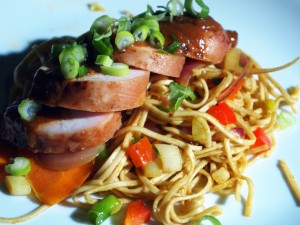 Singapore noodles are another dish with a misleading name. They don’t appear at all in Singapore, despite their ubiquity on Hong Kong, UK, US and other Chinese restaurant menus. It’s unclear where the recipe originates, but it’s now a take-away standard. I suppose it makes sense; Singaporean and Malaysian food is characterised as being a bold, mish-mash of cultures, and this dish fits that description well.
Singapore noodles are another dish with a misleading name. They don’t appear at all in Singapore, despite their ubiquity on Hong Kong, UK, US and other Chinese restaurant menus. It’s unclear where the recipe originates, but it’s now a take-away standard. I suppose it makes sense; Singaporean and Malaysian food is characterised as being a bold, mish-mash of cultures, and this dish fits that description well.
Given that noodles in this style are something of a made-up dish, I allowed myself some latitude when I couldn’t find all the ingredients I wanted to use. You’ll see beansprouts in the ingredient list below, and they do make for a much more interesting mouthful, so include them if you can. There appears to be a beansprout drought in these parts at the moment, so you won’t see any in the photo. I’ve used a wheat/egg ramen noodle rather than the traditional rice vermicelli you often find in restaurants; this isn’t such an odd choice, and you’ll find many UK Chinese restaurants using a wheat noodle, but some do prefer vermicelli, so substitute them if you’re a particular fan. As always with curry powder, find the best you can. There’s a world of difference between those jars from Sharwood’s and Bart’s and a good curry powder from a small producer. Malaysian curry powder is preferable here, if you can find it, for its complex and herbaceous aromatics.
The chicken, sweet and intensely umami, is a lovely foil to the noodles. Marinate it overnight if possible. The marinade, boiled through thoroughly, makes a fine dipping sauce to go alongside this meal, or can be spooned over in small quantities. The sauce is packed with flavour, so you won’t need much. You can, of course, cook the chicken separately from the noodles; it’s fantastic cold and makes a very good sandwich filling or, diced, a Chinese salad addition.
To serve two, you’ll need:
Noodles
200g thin ramen or rice vermicelli
6 spring onions
1 medium red onion
1 red pepper
1 carrot
75g beansprouts
3 cloves garlic
2 tablespoons of your favourite curry powder
30ml rice wine
2 tablespoons light soy sauce
Small amount of oil to stir fry
Chicken
2 skinless, boneless breasts
2 tablespoons white miso
2 tablespoons rice wine
2 tablespoons oyster sauce
1 tablespoon light soy sauce
1 tablespoon soft brown sugar
1 teaspoon sesame oil
Marinate the chicken overnight in all the chicken ingredients (or for at least six hours). Remove from the marinade and grill under a medium flame for 8-10 minutes per side until done while you cook the noodles. Put the remaining marinade in a little pan and bring it to a rolling boil for a couple of minutes, then put to one side until you are ready to serve.
Chop the spring onions into coins, chop the garlic, slice the onion, dice the pepper and cut the carrot into thin diagonal slivers. Prepare the noodles for stir-frying by following the instructions on the packet. In your wok, take a little groundnut or grapeseed oil, and fry the spring onions, garlic, onion and pepper with the curry powder over a very high heat, moving everything around all the time, until the onion takes on a little char at the edges (only a few minutes). Add the noodles, carrots and beansprouts to the wok. Stir-fry until everything is well mixed, then add the liquid ingredients. Stir through again, turn the heat down and put a lid on the pan for 2 minutes before serving.
Dish the noodles out and slice the chicken breasts on the diagonal before placing them on top of the noodles with a little of the cooked marinade. Serve immediately.
